Conscientious travel choices in a time of global warming are not easy. The ethically driven, non-flying British traveller, you might think, will have to accept a life of self-denial: no snorkelling over coral reefs, no wolf watching or walking on glaciers. And what about other wonders, both natural and human-made? Will we never again explore an active volcano, burrow into a bazaar, or lie on a palm-fringed beach beside a warm turquoise sea? I don’t think I’m the only one who recoils in horror at the thought of every summer holiday being a UK washout, counting your goosebumps while sheltering in the bandstand.
Over the past two decades, in our rush to embrace budget airlines, other transport systems were allowed to wither, further limiting choices. All ferry routes to Scandinavia, for example, have disappeared, which is a scandalous state of affairs. Getting to Gothenberg, Bergen, Oslo and Esbjerg now entangles the traveller in complex railway journeys through several countries – hence the lack of Scandinavian alternatives in our list.
Even a classic tourist town like Bruges in Belgium has become trickier, with the closure of the Hull-Zeebrugge ferry route. The north and west of the UK have been particularly hit by this, with non-flyers forced towards London St Pancras and the Channel tunnel. This is an expensive addition to any trip, often requiring an overnight in London on both legs of a continental journey.
However, there is some good news: the coral reefs, glaciers and turquoise seas are all accessible, with one proviso: the journey must become part of the experience. So here is the plan: allowing 48 hours for travelling, where can you get to from the UK without getting on an aeroplane, and on a route that is both interesting and fun?
Travel this way and you will complete your trip comfortable in the knowledge that you have barely produced more CO2 than if you had stayed at home.
In terms of cost, these trips should not be compared to a budget flight – they are enriching travel experiences in themselves. Prices change regularly and vary depending on exact routes and timings. Useful websites for planning and pricing include directferries.co.uk, rome2rio.com, raileurope.com and thetrainline.com, but it’s also worth checking out individual operators.
The estimates given here are a rough guide for a solo traveller, one way from London St Pancras unless stated otherwise, including only basic transport costs in April.
Glacier hikes, Switzerland
Under 36 hours
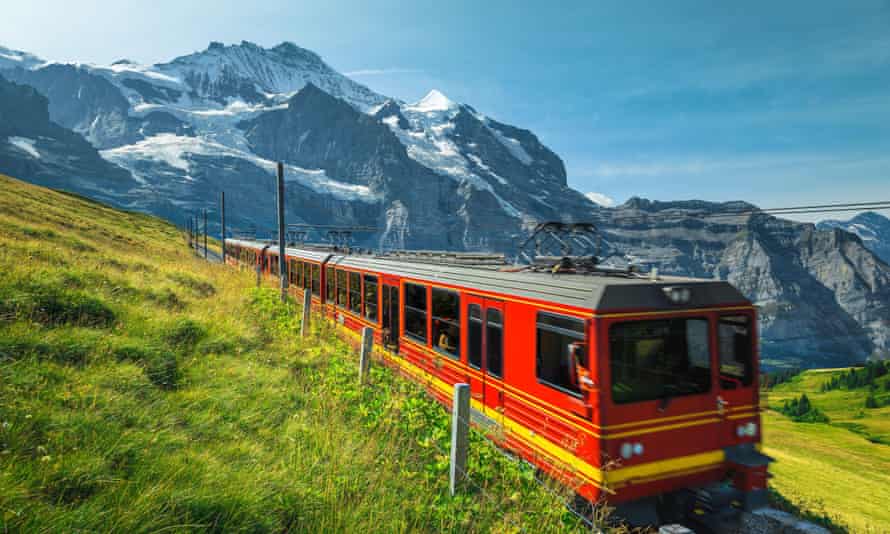
If you go to the trouble of reaching mainland Europe without wings, you have certainly earned the right to visit a glacier – a questionable activity for anyone travelling by aeroplane. European glaciers less than about 45 degrees north of the equator may not be long for this world, but they do exist.
Bulgaria’s Snezhnika and Banski Suhodol in the Pirin mountains are the furthest south. Albania, Montenegro and Spain also have areas that pass muster as perennial areas of ice. Given the rate of global warming, however, it may be safer to head for the largest volume of ice that currently exists in the Alps, the 10bn-tonne Aletsch glacier, which is 800 metres thick in places, albeit 200 metres thinner than in 1860.
From London, the train to Interlaken takes about 10 hours via Paris and Basel. Spend a night there, or hop up to Grindelwald. Next morning, catch the Jungfraujoch railway: this line spirals up inside the mountain, emerging 3,450 metres up at the head of the Aletsch glacier field. To get your feet on the ice, walk across to the Mönchsjoch hut. It takes about 45 minutes. Alternatively, hike to the Konkordia hut for a night – tours are available. The new Eiger cableway also allows a panoramic version of the journey, but for me the engineering marvel of the railway inside the Alp is unique.
That’s all very cushy. For a more energetic alternative, take a train to the lovely Swiss village of Fiesch (an 11-hour journey from London, with changes in Paris, Lausanne and Visp), then spend a night in the village before taking the cable car to Eggishorn for the panoramic Aletsch view. Or take a cable car to Fiescheralp, walk to Eggishorn and stay at Gletcherstube hut. Within 36 hours you will be sleeping beside a glacier. There are numerous excellent winter walks.
Estimated cost, one way Train to Interlaken £116, Jungfrau trip £85 (round trip). Total: £201.
Coral reef, Tunisia
Just under 48 hours
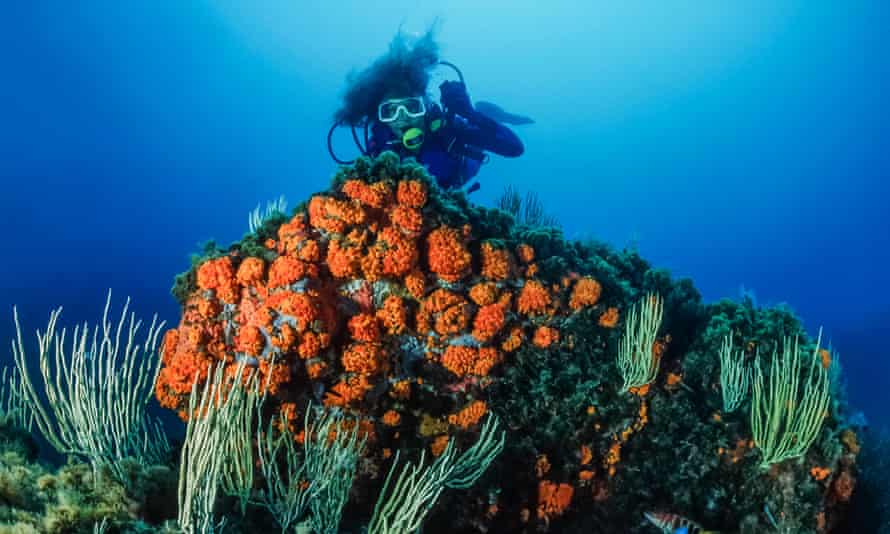
There are those who will tell you that the UK does have coral reefs, and they are correct. Extensive areas of Lophelia pertusa coral were discovered off the Hebrides in 2003. You’re unlikely to be snorkelling over them any time soon, however, as they sit 100 metres beneath the surface, at around about the depth limit for a world-class freediver. What is required is a reef under warm water, and that does pose a challenge. As recently as 2019, researchers in Italy discovered a reef off the coast of Puglia, but once again there was a caveat: this is a mesophotic reef, a low-light version that lives at below 30 metres, not the full-colour, tropical variety. For the nearest thing to a Great Barrier Reef experience, you have to go to Tunisia.
Ferry companies always warn passengers to check for “operational changes” and Tunis gets its share. In season you can find services from the Italian ports of Palermo, Salerno (Naples) and Civitavecchia (Rome), but the closest to the UK is Genoa.
Starting at London St Pancras, your objective is to catch a Wednesday or Saturday GNV ferry sailing to Tunis, which will probably mean leaving on a Friday afternoon for the Saturday sailing (the journey takes about 20 hours with changes depending on the route). Once you roll into Genoa’s Voltri station, you will wish you had a week to spare for this fine Ligurian city. Sadly we are on a mission and must skip past sights like the Doge’s Palace and Via Garibaldi to take a short bus ride or walk down to the port and the GNV ticket office for checking in (it usually leaves around 3pm). The ferry voyage takes about 24 hours.
Once you are out of Tunis port – and it can be a little chaotic – get a taxi for the three-hour ride to Tabarka. So you should be able to check in to your hotel and get down to the beach within 48 hours of setting off. Tabarka is actually a castellated rocky promontory that projects into the Mediterranean from the small town. There’s an extensive coral reef not far from shore, and you can snorkel straight off the beach at Tabarka, or go on day trips to various dive sites. The small La Galite islands also lie 35 miles offshore in a nature reserve that’s also home to Mediterranean monk seals.
Estimated cost, one-way Train £143, ferry £82, bus £4 (taxi £40). Total: £229 (£265).
Wolf watching, Spain
About 27 hours
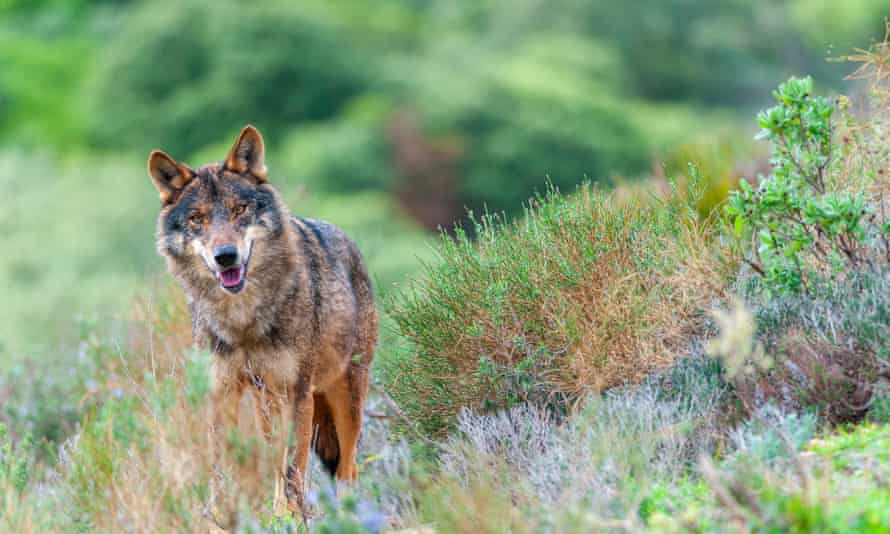
Large predators were banned from Britain long ago because they interfered with mutton production, so travellers have to head abroad for a sighting. So is it possible to leave British soil and go wolf, bear or lynx watching within 48 hours?
To be honest, it’s unlikely, but not impossible. Rural depopulation in western Europe has certainly led to a resurgence of the wolf. A lone animal was caught on CCTV just 18 miles from Dieppe, northern France, in 2021 – hopefully heading for the Newhaven ferry. The best spot, however, is undoubtedly the Picos de Europa, a wild area of mountain and forest that spreads for 250 sq miles across northern Spain.
Take the Brittany ferry service from Plymouth (Wed and Sun), arriving early afternoon the next day in Santander ready to hire a car and get up to a village such as La Hermida, from where you can walk into the high sierras. Going with an expert guide will definitely help. A three-hour drive from Santander is Riaño, in Leòn province, where you can join a tour with a local operator such as WildWatching. There are also no-fly options on tours run from the UK by Naturetrek.
Estimated cost, one-way Ferry £101, car hire from £18 a day. Total: from £119
Active volcano, Sicily
About 36 hours

Europe is home to more than 60 active volcanoes, but it’s impossible to know when any of them will next burst into life, making volcanology holidays a tricky business. The spectacular Fagradalsfjall in western Iceland simply ground to a halt on 18 September 2021, having been spouting lava copiously for many months.
Furthermore, to a volcanologist an active volcano is one that erupted in the past 10,000 years and still shows signs of activity – not long in geological time, perhaps, but we are in a hurry and want sight of lava spilling from a jagged fissure in the Earth’s crust within our 48-hour time limit.
The Smithsonian keeps a weekly report of current eruptions, but most are very far away from the UK. The closest is probably the Phlegraean Fields, an area of 24 calderas west of Naples, where you can see fumaroles and ash cones, but not red-hot rock. Nearby Vesuvius has not erupted since 1944 and is not expected to blow again any time soon. Cumbre Vieja in the Canaries is erupting and can be accessed without wings (ferry from Cadiz), but sadly not inside 48 hours. The best candidate is Etna, a reliably rambunctious erupter.
Take the train to Salerno, south of Naples, a journey of around 24 hours from London St Pancras (with four changes), then hop on the Caronte ferry to Messina, departing around 14.30 (times vary according to the day). It’s a nine-hour voyage, during which you will pass the island of Stromboli, another dependable performer, where there was a large pyroclastic flow in August 2019. (You can reach Stromboli from Naples on the hydrofoil in summer.)
You might also glimpse another volcano, the island of Vulcano, which is one of the Aeolian group. It’s exhaling smoke and gases at the moment, but no lava.
After a brief sleep in Messina, get on the train to Catania, from where you can join a summit tour (the only way to visit the very top of Etna). If you prefer to remain self-guided, stick to the lower-altitude Silvestri craters, though these are inactive.
Estimated cost, one-way Train £202, ferry £25, summit tour £47. Total: £274
Oriental bazaars, Albania and Bosnia-Herzegovina
About 48 hours from the UK
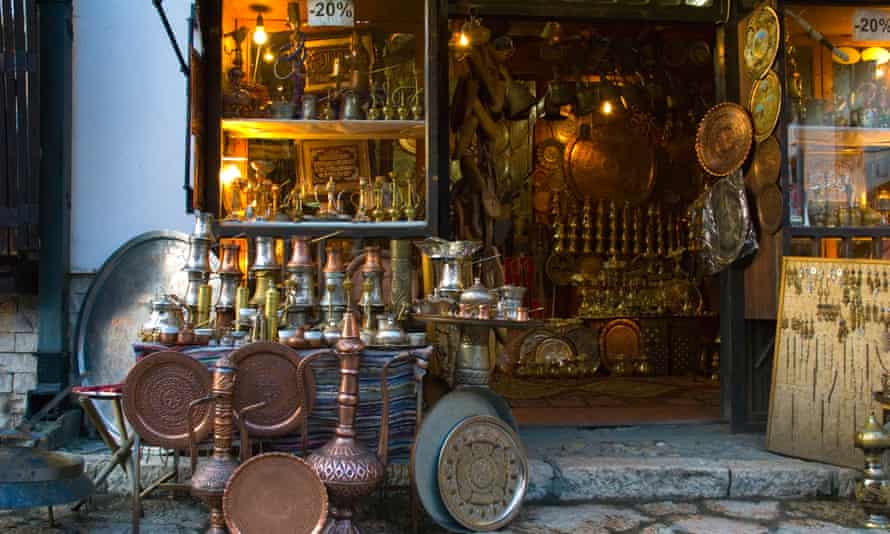
Who does not love a shopping centre? By which I do not mean a soulless trudge through chain stores, but the finest consumer experience available on the planet – an oriental bazaar, preferably one built during the Ottoman empire. Istanbul and Isfahan spring to mind as the sublime apotheosis of silky consumerism: piles of spices, hand-woven textiles and rugs, perfumiers who will blend a fragrance to your specification, tea shops and hookah pipes, gemstones and curiosities.
Sadly, even in its 1930s heyday, the Orient Express never made it to Istanbul within 48 hours, and the service came to a halt in 2009 (though a luxury service operates as the Venice-Simplon Orient Express).
Tunis is a good bet (see our coral reef trip, above) but check out Bosnia and Albania, both of which spent long enough under Ottoman rule to develop good bazaars, which operate still.
In pre-Covid times, Sarajevo could be reached directly from London’s Victoria coach station in a single, character-building, bum-busting bus yomp. Slightly more pleasant, perhaps, would be the overnight ferry from Newcastle to Amsterdam (or Harwich-Hook of Holland) and then rail to Passau or Linz on the Germany-Austria border (10 hours), then coach (12 hours)to Sarajevo. Check in to a decent small place like Hotel Aziza, and head for the copper-bashing street of Kazandžiluk in the Stari Bazar.
Albania offers a chance to mix things up a bit more: train to Milan, then on south to Bari, followed by an overnight ferry to Durres (departs 22.00), a bus to Tirana, then a taxi to Krujë, where there is a street bazaar. It’s not Aleppo’s Khan al-Harir, but it’s still lovely.
Estimated cost to Sarajevo, one-way Ferry £102, train to Passau £33, coach to Sarajevo £35. Total: £170
Estimated cost to Krujë, one-way Train to Bari £148, ferry to Durres £38, bus £4 Krujë (taxi £25). Total: £192 (£211)
Caribbean-style beaches, Mallorca
About 26 hours
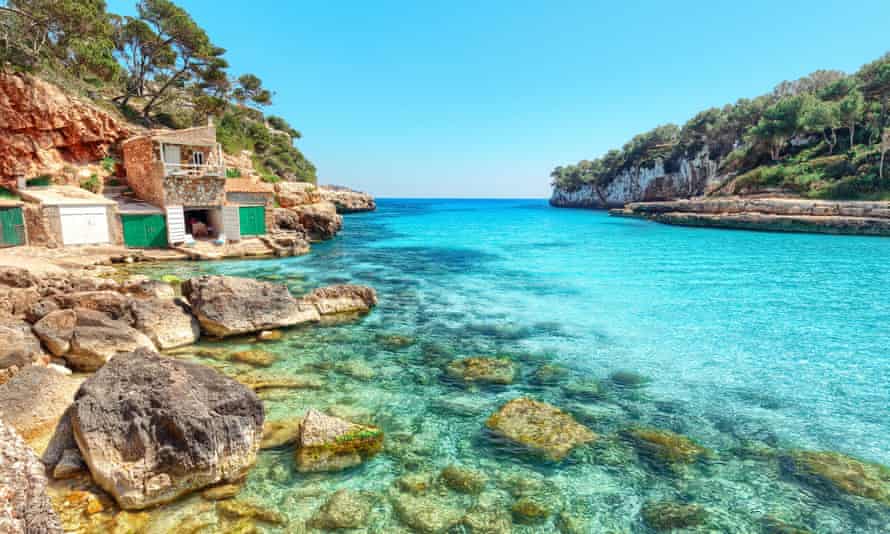
Lovers of the Cornish Riviera might argue otherwise, but I don’t think Britain can really claim to have a palm-fringed beach, let alone a Caribbean-style one – and carrying your Swiss cheese plant down to Brighton’s shingle doesn’t count. What we require is finely ground white sand washed by a limpid turquoise sea, and then, up the beach, in the shade of a coconut palm, a homespun shack serving fried plantains and glasses of rum punch.
Unfortunately, despite global warming, the tropics are not getting any closer. The areas of the planet where the sun is directly overhead remain resolutely distant. The only possible point of contact for the flightless globetrotter is Africa.
You could be on a ferry to and well on your way to Morocco, Algeria or even the Canary Islands within 48 hours of leaving Britain (via Barcelona, Marseille and Cadiz respectively), but not actually arriving; so we shall reluctantly discount such exotic destinations.
Sign up to our Inside Saturday newsletter for an exclusive behind the scenes look at the making of the magazine’s biggest features, as well as a curated list of our weekly highlights
And then there is the difficulty of “palm-fringed” – do we allow planted palms, or must they be natural? To be honest, insistence on wild, self-planted palms is not helpful in this case. Villefranche-sur-Mer on the Côte d’Azur is palm-fringed, and lovely, but the horny hands of some jardinier were involved. But why do we want palms at all? For shade. My suggestion, therefore, is Caribbean-style Cala Llombards on Mallorca – it has the perfect white sand and turquoise warm seas, plus shady trees, even though they are pines.
An early train from London will get you to Barcelona in time to board the ferry to Mallorcan capital Palma that same evening. GNV seems to be the cheapest option, but there are other companies. Or you could start out later in the day and spend a night in Paris. Either way you will arrive in Palma at about 6am, which gives you the day to hire a car and drive the 40 miles east to Cala Llombards. As for the fried plantain and rum punch, best to head to Palma’s wonderful Mercat de Santa Catalina for toothsome local specialities.
Estimated cost, one-way
Train £110, ferry £15, car hire £29 a day. Total: from £154
 Top Naija News: Nigerian News, Breaking News Nigeria and World News Top Naija News is a daily news publication in Nigeria, delivering the latest breaking news in Nigeria and around the world.
Top Naija News: Nigerian News, Breaking News Nigeria and World News Top Naija News is a daily news publication in Nigeria, delivering the latest breaking news in Nigeria and around the world.



